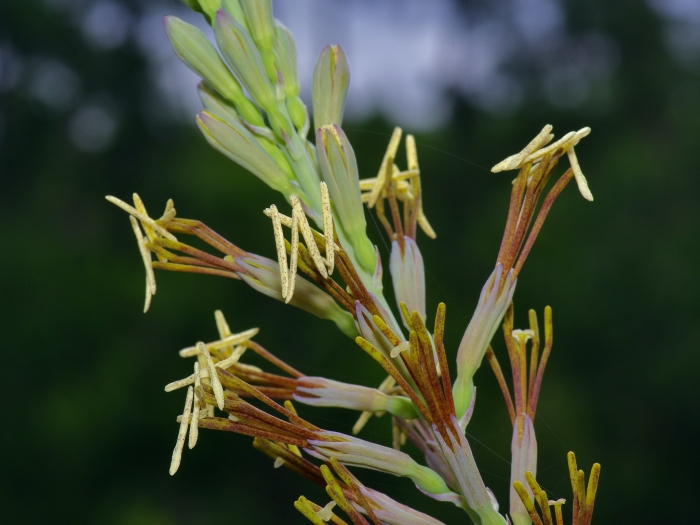False Aloe
(Agave virginica)
False Aloe (Agave virginica)
/
/

Michelle W.
CC BY 4.0
Image By:
Michelle W.
Recorded By:
Copyright:
CC BY 4.0
Copyright Notice:
Photo by: Michelle W. | License Type: CC BY 4.0 | License URL: http://creativecommons.org/licenses/by/4.0/ | Rights Holder: Michelle W. | Publisher: iNaturalist | Date Created: 2021-06-29T09:48:57-07:00 |
















































Estimated Native Range
Summary
Agave virginica, commonly known as False Aloe, is a perennial herbaceous succulent native to the open woodlands, grasslands, and rocky outcrops of the Central and Southern United States, as well as Northeastern Mexico. It typically grows to a height of 2-3 feet (0.6-0.9 meters) with a similar spread. The plant features rosettes of fleshy green leaves that are often spotted or speckled with maroon, adding to its ornamental appeal. During the flowering season from early summer to late summer, and occasionally in spring, False Aloe produces an impressive inflorescence up to 68 cm (27 in) tall. The inflorescence bears 10–61 closely spaced flowers that are sessile or pedicellate, nearly erect, and slender, emitting a fragrant sweet fruity odor. The flowers are particularly showy, attracting hummingbirds, bees, and moths, which are essential for pollination.
False Aloe is valued for its drought tolerance and unique foliage, making it a suitable choice for xeriscaping, rock gardens, and as an accent plant in water-wise landscapes. It thrives in full sun to part shade and requires very low to low amounts of water, preferring well-drained soils. While it is generally low-maintenance, it is important to avoid overwatering to prevent root rot. False Aloe is not known for aggressive roots or significant disease problems, but it can be susceptible to mealybugs and scale insects. Gardeners should also be aware that the sap of Agave species can cause skin irritation in some individuals.CC BY-SA 4.0
False Aloe is valued for its drought tolerance and unique foliage, making it a suitable choice for xeriscaping, rock gardens, and as an accent plant in water-wise landscapes. It thrives in full sun to part shade and requires very low to low amounts of water, preferring well-drained soils. While it is generally low-maintenance, it is important to avoid overwatering to prevent root rot. False Aloe is not known for aggressive roots or significant disease problems, but it can be susceptible to mealybugs and scale insects. Gardeners should also be aware that the sap of Agave species can cause skin irritation in some individuals.CC BY-SA 4.0
Plant Description
- Plant Type: Succulent
- Height: 3-6 feet
- Width: 3-4 feet
- Growth Rate: Moderate
- Flower Color: Yellow, Green
- Flowering Season: Summer, Fall
- Leaf Retention: Evergreen
Growth Requirements
- Sun: Full Sun, Part Shade
- Water: Very Low, Low
- Drainage: Fast
Common Uses
Bee Garden, Bird Garden, Drought Tolerant, Fire Resistant, Fragrant, Hummingbird Garden, Low Maintenance, Rabbit Resistant, Rock Garden
Natural Habitat
Native to open woodlands, grasslands, and rocky outcrops
Other Names
Common Names: Rattlesnake Master, American Aloe, Virginia Agave
Scientific Names: , Manfreda virginica, Agave virginica, Polianthes virginica, Agave lata, Manfreda virginica subsp. lata, Manfreda virginica var. tigrina, Polianthes lata, Agave alibertii, Agave conduplicata
GBIF Accepted Name: Agave virginica L.